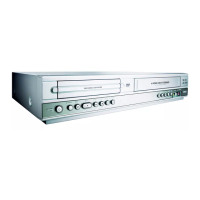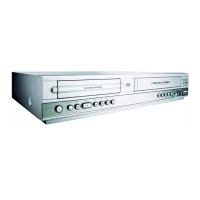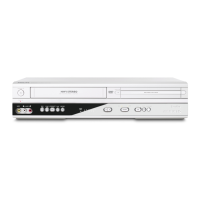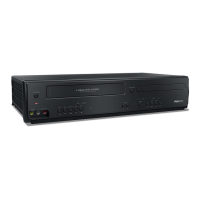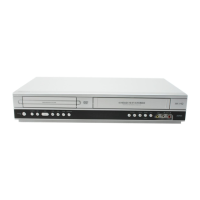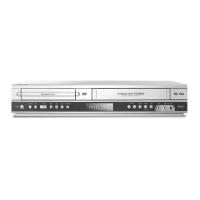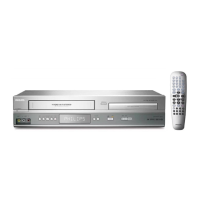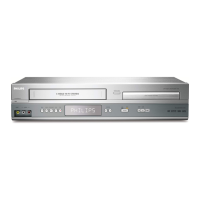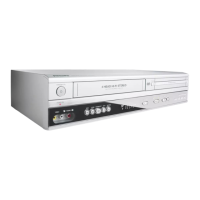Do you have a question about the Philips DVP721VR/14 and is the answer not in the manual?
Details on copyright restrictions and the importance of recording the unit's serial number.
Notes on high definition TV compatibility and warnings regarding laser product safety.
Highlights the unit's capabilities, including versatile disc playback and VCR recording.
Lists compatible disc formats and defines key terms like Title, Chapter, and Track.
Covers optimal remote control range, angle, and proper battery installation.
Provides guidance on safely handling and cleaning the unit's exterior surfaces.
Details how to handle, store, and clean discs to prevent damage and ensure playback.
Explains unit symbols and instructions on selecting the correct TV input source.
Identifies and describes the buttons, jacks, and compartments on the unit's front panel.
Explains the various status indicators shown on the unit's front display window.
Explains how to select the source and use core buttons like Power and Eject.
Details buttons for playback, skipping tracks, and searching within discs or tapes.
Covers buttons for recording, accessing menus, and activating features like Subtitle or Angle.
Details connections for TV, amplifiers, and receivers via AV, Component, and S-Video.
Explains connections for digital audio (Optical, Coaxial) and RF output to TV.
Describes AV input jacks for external devices and the AC power connection.
Guides on connecting to a TV and decoder using SCART or RF cables.
Details advanced connections like Component Video and S-Video for superior picture quality.
Explains setting up progressive scan for high-definition output and important considerations.
Instructions for connecting to audio systems for stereo or multi-channel sound.
How to set up optical or coaxial digital audio outputs for optimal sound.
Explains the benefits of digital multi-channel sound and potential warnings.
Guides on initial connection, power-on, and automatic channel memory system (ACMS).
Step-by-step instructions for manually setting the unit's internal clock and date.
How to select the correct color system (PAL, SECAM) for video playback.
Steps for tuning TV channels when using an RF connection, including manual adjustments.
Explains how to access and use the VCR's on-screen main menu system.
Details the process of using the Automatic Channel Memory System to tune TV stations.
Guides on manually tuning weak broadcast signals and storing them.
Instructions for naming stations and confirming their placement in the station list.
How to reorder stored TV stations without retuning.
Steps to remove specific TV stations from the VCR's memory.
Methods to select tuned stations using navigation or direct number entry.
How to access and interpret the on-screen playback status and options.
Details on controlling Title, Chapter, Time Search, Audio, and Subtitle settings.
Explains playback controls specific to VCD (PBC) and DivX discs.
How to access, navigate, and exit the DVD setup menu for preferences.
Setting preferences for menu language, disc audio, and subtitles.
Configuring TV aspect ratio (4:3, 16:9) and display modes (Letterbox, Panscan).
Setting up progressive scan output and selecting TV output types (YPbPr, RGB).
Configuring audio output for Dolby Digital, DTS, MPEG, and Hi-Fi stereo modes.
Managing Video CD PBC, automatic DVD playback, and DivX VOD registration.
How to set, change, or clear the parental control password.
Setting disc rating levels and enabling/disabling parental control.
Selecting the appropriate country code for DVD region compatibility.
Basic steps for playing tapes and manually adjusting tracking for picture quality.
Using slow motion, shuttle speeds, and pause/frame-by-frame playback.
Activating OPR to automatically improve tape playback picture quality.
How to start recording immediately for a set duration or until the tape ends.
Selecting recording speeds and choosing input sources (SCART, AV) for recording.
Using ShowView codes to simplify timer recording setup.
Setting recording types (ONCE, WEEKLY, DAILY) and understanding VPS for accurate recording.
Step-by-step guide to setting up multiple timer recording events via the on-screen display.
Instructions for modifying or deleting existing timer recordings.
Initial steps for playing DVDs and VCDs, including disc loading and menu navigation.
How to navigate through disc content like titles, chapters, and tracks.
Using search features and pausing playback for frame-by-frame viewing.
Controls for slow motion, random track playback, and various repeat modes.
Advanced playback features like repeating sequences, time-based search, and simulated surround sound.
Information on the screen saver and notes related to VCD PBC usage.
How to enlarge images, move within zoomed views, and set/recall playback markers.
Navigating disc menus and selecting different camera angles for scene playback.
Changing audio languages, subtitle tracks, and understanding DivX file format notes.
Steps for playing standard audio CDs, including track selection.
How to play MP3 files and important compatibility requirements for MP3 discs.
Controls for pausing playback, moving between tracks, and searching within discs.
Using repeat functions, repeat A-B, and activating 3D surround sound.
How to navigate JPEG folders, view files, and use the slideshow feature.
Adjusting JPEG image views and playing music simultaneously.
Important notes regarding JPEG file size, format, and naming conventions.
How to create and manage custom playback sequences for audio, MP3, and VCDs.
Using repeat functions for programmed playback and removing tracks or the entire list.
Steps for playing DVD-RW discs recorded in VR format.
Explanation of CPRM technology and its implications for recording and playback.
Information on supported DivX file types, codecs, and video mode adjustments.
Specific advice and limitations related to playing DivX movie files.
How to display various status information on the TV screen.
Using the tape counter memory and activating/deactivating the child lock feature.
Utilizing the self-diagnosis feature to identify VCR problems and error codes.
Setting up Hi-Fi stereo, NICAM, and mono sound modes for VCR playback.
Configuring 16:9 aspect ratio and setting up external decoders.
How the unit remembers the last playback position for discs.
Instructions for dubbing DVD content onto VHS tapes, including notes on copy protection.
Steps for recording from other video recorders or camcorders via SCART or AV inputs.
Solutions for problems like the unit not working or having no power.
Troubleshooting steps for poor picture quality, no picture, or no sound.
Solutions for discs not playing, remote control malfunctions, and tape insertion problems.
Details power requirements, dimensions, operating conditions, and RF modulator.
Technical details for VCR audio and video inputs and outputs.
Technical details for DVD video and audio outputs, including digital formats.
Details on copyright restrictions and the importance of recording the unit's serial number.
Notes on high definition TV compatibility and warnings regarding laser product safety.
Highlights the unit's capabilities, including versatile disc playback and VCR recording.
Lists compatible disc formats and defines key terms like Title, Chapter, and Track.
Covers optimal remote control range, angle, and proper battery installation.
Provides guidance on safely handling and cleaning the unit's exterior surfaces.
Details how to handle, store, and clean discs to prevent damage and ensure playback.
Explains unit symbols and instructions on selecting the correct TV input source.
Identifies and describes the buttons, jacks, and compartments on the unit's front panel.
Explains the various status indicators shown on the unit's front display window.
Explains how to select the source and use core buttons like Power and Eject.
Details buttons for playback, skipping tracks, and searching within discs or tapes.
Covers buttons for recording, accessing menus, and activating features like Subtitle or Angle.
Details connections for TV, amplifiers, and receivers via AV, Component, and S-Video.
Explains connections for digital audio (Optical, Coaxial) and RF output to TV.
Describes AV input jacks for external devices and the AC power connection.
Guides on connecting to a TV and decoder using SCART or RF cables.
Details advanced connections like Component Video and S-Video for superior picture quality.
Explains setting up progressive scan for high-definition output and important considerations.
Instructions for connecting to audio systems for stereo or multi-channel sound.
How to set up optical or coaxial digital audio outputs for optimal sound.
Explains the benefits of digital multi-channel sound and potential warnings.
Guides on initial connection, power-on, and automatic channel memory system (ACMS).
Step-by-step instructions for manually setting the unit's internal clock and date.
How to select the correct color system (PAL, SECAM) for video playback.
Steps for tuning TV channels when using an RF connection, including manual adjustments.
Explains how to access and use the VCR's on-screen main menu system.
Details the process of using the Automatic Channel Memory System to tune TV stations.
Guides on manually tuning weak broadcast signals and storing them.
Instructions for naming stations and confirming their placement in the station list.
How to reorder stored TV stations without retuning.
Steps to remove specific TV stations from the VCR's memory.
Methods to select tuned stations using navigation or direct number entry.
How to access and interpret the on-screen playback status and options.
Details on controlling Title, Chapter, Time Search, Audio, and Subtitle settings.
Explains playback controls specific to VCD (PBC) and DivX discs.
How to access, navigate, and exit the DVD setup menu for preferences.
Setting preferences for menu language, disc audio, and subtitles.
Configuring TV aspect ratio (4:3, 16:9) and display modes (Letterbox, Panscan).
Setting up progressive scan output and selecting TV output types (YPbPr, RGB).
Configuring audio output for Dolby Digital, DTS, MPEG, and Hi-Fi stereo modes.
Managing Video CD PBC, automatic DVD playback, and DivX VOD registration.
How to set, change, or clear the parental control password.
Setting disc rating levels and enabling/disabling parental control.
Selecting the appropriate country code for DVD region compatibility.
Basic steps for playing tapes and manually adjusting tracking for picture quality.
Using slow motion, shuttle speeds, and pause/frame-by-frame playback.
Activating OPR to automatically improve tape playback picture quality.
How to start recording immediately for a set duration or until the tape ends.
Selecting recording speeds and choosing input sources (SCART, AV) for recording.
Using ShowView codes to simplify timer recording setup.
Setting recording types (ONCE, WEEKLY, DAILY) and understanding VPS for accurate recording.
Step-by-step guide to setting up multiple timer recording events via the on-screen display.
Instructions for modifying or deleting existing timer recordings.
Initial steps for playing DVDs and VCDs, including disc loading and menu navigation.
How to navigate through disc content like titles, chapters, and tracks.
Using search features and pausing playback for frame-by-frame viewing.
Controls for slow motion, random track playback, and various repeat modes.
Advanced playback features like repeating sequences, time-based search, and simulated surround sound.
Information on the screen saver and notes related to VCD PBC usage.
How to enlarge images, move within zoomed views, and set/recall playback markers.
Navigating disc menus and selecting different camera angles for scene playback.
Changing audio languages, subtitle tracks, and understanding DivX file format notes.
Steps for playing standard audio CDs, including track selection.
How to play MP3 files and important compatibility requirements for MP3 discs.
Controls for pausing playback, moving between tracks, and searching within discs.
Using repeat functions, repeat A-B, and activating 3D surround sound.
How to navigate JPEG folders, view files, and use the slideshow feature.
Adjusting JPEG image views and playing music simultaneously.
Important notes regarding JPEG file size, format, and naming conventions.
How to create and manage custom playback sequences for audio, MP3, and VCDs.
Using repeat functions for programmed playback and removing tracks or the entire list.
Steps for playing DVD-RW discs recorded in VR format.
Explanation of CPRM technology and its implications for recording and playback.
Information on supported DivX file types, codecs, and video mode adjustments.
Specific advice and limitations related to playing DivX movie files.
How to display various status information on the TV screen.
Using the tape counter memory and activating/deactivating the child lock feature.
Utilizing the self-diagnosis feature to identify VCR problems and error codes.
Setting up Hi-Fi stereo, NICAM, and mono sound modes for VCR playback.
Configuring 16:9 aspect ratio and setting up external decoders.
How the unit remembers the last playback position for discs.
Instructions for dubbing DVD content onto VHS tapes, including notes on copy protection.
Steps for recording from other video recorders or camcorders via SCART or AV inputs.
Solutions for problems like the unit not working or having no power.
Troubleshooting steps for poor picture quality, no picture, or no sound.
Solutions for discs not playing, remote control malfunctions, and tape insertion problems.
Details power requirements, dimensions, operating conditions, and RF modulator.
Technical details for VCR audio and video inputs and outputs.
Technical details for DVD video and audio outputs, including digital formats.
| operating temperature range | 5˚C to 35˚C |
|---|---|
| operating humidity range | 5 % to 90 % |
| timer | 24 hours display type |
| power requirements | AC 220-230V, 50Hz |
|---|---|
| power consumption | 19W |
| laser wavelength | 650 nm |
|---|---|
| frequency response (DVD PCM 96 kHz) | 8 Hz to 44 kHz |
| frequency response (DVD PCM 48 kHz) | 8 Hz to 22 kHz |
| video out | 1 Vp-p 75 ohms |
|---|---|
| s-video out (Y) | 1 Vp-p 75 ohms |
| component video out (Y) | 1 Vp-p 75 ohms |
| dimensions | 430 X 78.5 X 265 mm |
|---|---|
| weight | 4.06 kg |
